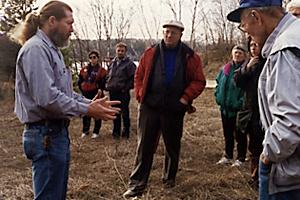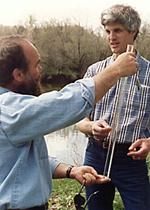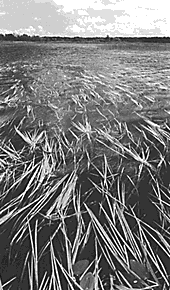To the Tidings Newsletter Index Page The Official Newsletter of the Mississippi Headwaters Board |
To the Tidings Newsletter Index Page The Official Newsletter of the Mississippi Headwaters Board |
| Volume 12, Number 5 | May 28, 1996 |
|
Students Take River Watch to International Science Fair  Bagley High School seniors Scot Surdez and Michelle Trucke brought their Mississippi Headwaters water quality project to the International Science Fair in Tucson last week. The two seniors were the top team at regional and state Science Fair competitions in March and April.
Bagley High School seniors Scot Surdez and Michelle Trucke brought their Mississippi Headwaters water quality project to the International Science Fair in Tucson last week. The two seniors were the top team at regional and state Science Fair competitions in March and April.Their project, "Counting Critters: An Analysis of the Effects of Water Quality on Macroinvertebrates," reported their five years of participation in the Mississippi Headwaters River Watch Project. The display describes the relationship between the chemistry of river water and the number and types of aquatic insects found at five sampling sites located between Itasca State Park and Coffee Pot Landing, on the border between Clearwater and Hubbard counties.  Their research found that when dissolved oxygen levels dropped, the number and types of aquatic insects declined. They also found that excessive levels of fecal coliform bacteria may be related to declines in aquatic insects. Increases in total phosphorus were associated with increase in numbers of snails found in the river. Their research found that when dissolved oxygen levels dropped, the number and types of aquatic insects declined. They also found that excessive levels of fecal coliform bacteria may be related to declines in aquatic insects. Increases in total phosphorus were associated with increase in numbers of snails found in the river.Bottom-dwelling insects (known as benthic macroinvertebrates) are considered good indicators of water quality because they require relatively high levels of oxygen, remain on the river bottom for up to several years and tend to stay in one place. The nymph or larval stages of mayflies, caddisflies and stoneflies are important food for game fish, trout and suckers. "Our project focuses on our need to maintain the quality of the Mississippi River, to ensure that the food chain continues. Water management is essential to all of the living organisms found in the river, including macroinvertebrates," they reported. Surdez will attend the University of Minnesota in the fall, and Trucke intends to enroll at Bethel College. They both received awards from Mississippi Headwaters River Watch Project for their science fair accomplishments. Bruce Schultz, Pequot Lakes Middle School, also received a River Watch award for his project evaluating conditions affecting erosion on shorelines. |
|
Emergency Preparedness of Mississippi River Towns Assessed The ability of Mississippi River towns to respond immediately to a spill of hazardous materials is limited, according to an assessment of equipment and personnel by the U.S. Army Corps of Engineers. The results were reported to the River Defense Network and the Minnesota Department of Emergency Management (DEM) at a Little Falls meeting in April. This is the first report on a two-year study by the Corps helping river communities evaluate preparedness in the event of spills of hazardous materials. The Corps’ study is funded by an appropriation from the 1995 Minnesota Legislature, as recommended by the Legislative Commission on Minnesota Resources. “We all have to talk the same language,” DEM official Jim Franklin said at the workshop. “We don’t command and control anymore. We have to coordinate, cooperate and share.” State personnel are working with county emergency managers to enhance emergency response training on the Mississippi River. The River Defense Network is working to bring local water managers into these discussions. The River Defense Network is an association of agencies and organizations interested in preventing and mitigating spills of hazardous materials to the Mississippi River. Its work is coordinated by the Mississippi Headwaters Board and the Metropolitan Council. Further support is provided by the Blandin Foundation of Grand Rapids. Most supplies of boom and absorbent materials in towns such as Bemidji, Grand Rapids and Brainerd are held by industry required to keep these materials on hand. The lack of response materials is critical because spills occur unexpectedly and can move rapidly down river. Moreover, emergency response personnel in Mississippi River communities may not have been trained in responding to spills of hazardous materials. The Minnesota Pollution Control Agency is providing spills response training. County emergency managers agreed to work with the River Defense Network to increase participation in these training exercises. The Mississippi Headwaters Board will discuss the Corps report May 17. The Board is interested in assisting communities in acquiring necessary emergency response equipment. |
|
Explore the River, Monitoring Updates, Building Trails and Russia Trip River enthusiasts are invited to participate in Old Crow Wing Family Canoe Day, Sunday, June 2, and the Centennial Triathlon, Saturday, June 8th. Old Crow Wing Family Canoe Day is an annual event sponsored by the Minnesota Department of Natural Resources, Crow Wing County Muzzle Loaders, Crow Wing County Sheriff’s Water Patrol, Huntersville Outfitters, Friends of Old Crow Wing and Mississippi Headwaters Board. Paddlers launch from Kiwanis Park near West College Drive in Brainerd and float downstream to Crow Wing State Park. A fur trade encampment will be in progress at the park. The river trip takes about three hours. Shuttle service back to Brainerd is provided from the park. Call 218-829-8022 for information. The Centennial Triathlon is canoeing, biking and running over nearly 70 miles along the Mississippi River and through the Chippewa National Forest between Bemidji’s and Walker’s waterfront parks. Each town celebrates its centennial this year. Call 218-335-2689 for information. Minnesota Power chemist, Bob Lindahl helped MHB calibrate seven Hach DR 2000 spectrophotometers recently. The calibration must be performed annually at a professional lab in order to meet the quality assurance requirements of Mississippi Headwaters River Watch Project. The spec is used to analyze water samples for the presence of the nutrients nitrogen and phosphorus. Thanks, Bob for your help, and thanks also to Heidi Jagodinski for making it possible. MHB Advisory Committee member Roger Boatman has won grants from the Itasca Trails Task Force and gotten the go ahead for full proposals from the Iron Range Resources and Rehabilitation Board and the Central Minnesota Initiative Fund. Roger is proposing development of a set of Water Trail maps for the Mississippi Headwaters which will show natural and cultural features of the river from the perspective of the canoeist. The maps are tools for learning more about the value of the Mississippi, educate users about how to use the river while respecting it and may encourage more recreational use, Roger says. Terry Larson, another MHB Advisory Committee member, has learned to make stone tools and shared his new skill with sixth graders at Park Rapids Middle Schools. He learned the art from Grant Goltz and is eager to share his knowledge of prehistoric lifestyles with others interested in learning. Mississippi Headwaters River Watch Project teachers Wayne Pikal and Jon Rowe are travelling to Chelyabinsk in Russia this fall to introduce the concepts of water quality monitoring to three high schools there. Russian schools don’t have the equipment or resources to do hands-on science projects such as River Watch’s water quality monitoring, according to trip director, Rex Hein, Morris Area High School. Morris has recently joined the River Watch program. Chelyabinsk has some of the most polluted waters in the world, being the location for the former Soviet Union’s nuclear military weapons industry. Chelyabinsk has a northern boreal forest climate, located 1,000 miles east of Moscow in the Ural Mountains. MHB Director Molly MacGregor is helping to put together the monitoring program that will be brought to Russia. Russian students will visit Minnesota in April 1997. 
|
|
MHB provides information on timber harvest, archaeology Mississippi River property owners with questions about harvesting woodlots to protect water quality or heritage resources can consult new publications of the Mississippi Headwaters Board. The Board has published two new informational pamphlets, designed to instruct individuals about how timber harvesting can be managed to protect river values and why and how heritage, or cultural, resources are protected in Minnesota. “Mississippi Headwaters Forest Steward Booklet: Managing Your Woodlot and Protecting Your Shoreline” was written by Mark Jacobs, Assistant Aitkin County Land Commission and Chairman of the Mississippi Headwaters Board. The booklet introduces the private woodlot owner to basic tenets of forest management, according to the different forest types found in the Headwaters. Forestry practices designed to protect riparian values, biological diversity, aesthetics and water quality are described for upland and lowland pine forests and for upland and lowland hardwood communities. The booklet is very general in its presentation of material. Readers are urged to extend their interest by preparing a Forest Stewardship Plan on their property. “Heritage Resources” was written by Patricia Emerson, archaeologist for the Minnesota Department of Natural Resources’ Division of Forestry and the State Historic Preservation Office. The brochure defines heritage resources, summarizes known cultural uses in Minnesota and archaeological research of Minnesota’s cultural history and describes the rights and responsibilities of private property owners who may find they have cultural resources on their property. Funds for producing this brochure were provided by the DNR Forest Stewardship Project. Also available is a new brochure describing the basics of administering shoreland zoning in northern Minnesota. Copies of these publications are available from the MHB without charge. Call 218-547-7248 for information. Northwest Area Foundation funds state rivers group 
How Timber Harvest Can Improve Wildlife in a Floodplain Forest Harvesting the oak from a Mississippi River forest to encourage black ash seedlings will probably alter the number and type of wildlife species found there by changing the habitat conditions. Itasca County property owner David Parent plans to harvest mature bur oak to release black ash seedlings from competition with the larger trees. He asked the MHB to apply the Mississippi Headwaters Wildlife Habitat Relationship Data Base to his proposed 47 acre cut. Biologist John Mathisen reviewed Parent’s harvest plan and identified 75 vertebrate species (40 birds, 24 mammals and 11 amphibians and reptiles) associated with existing mature lowland deciduous forests near the Mississippi River. He then queried the data base and identified 125 species associated with a shrub sapling opening, which will be the plant community following harvest. Of these 125 species, 84 are birds, including 30 species which are neo-tropical migrants, 31 are mammals and 10 are amphibians and reptiles. In short, harvest of the mature trees will change the habitat conditions. As a result, the number of species likely to inhabit the site will increase, although the kinds of species will change. Mathisen noted that wildlife will continue to change as the site matures. The MHB provided this analysis to David Parent at no charge. Acquatic Plant Survey Indicates River Health 
“When we look at aquatic ecosystem, we see a myriad of life forms that range from microscopic organisms to sought after game fish. Though some may seem more desirable to us than others, most, if not all play a vital role in the overall health of the system,” McCartney writes in the manual. “Playing a key role are aquatic plants, which unfortunately, some are quick to view as “weeds” that must be removed. Often we don’t realize that the misguided “tug” can adversely affect the present and future quality of the lake or river we so enjoy,” she states. “Aquatic plants provide food and shelter for fish and wildlife as well as create safe havens for spawning and nesting activities. Aquatic plants help protect river banks and lake shorelines and bottoms from erosion by slowing runoff and wave action. By producing oxygen and absorbing nutrients they aid in improving water quality. Fishing and wildlife viewing is often best in and around aquatic plants. Finally, aquatic plants enhance the natural beauty of a lakeshore adding visual appeal,” the manual states. Because aquatic plants are so integral to water quality, they are excellent indicators of the health of a lake or river. “Mapping and monitoring them can aid us in understanding these roles, enabling us to make better decisions towards maintaining the recreational, economic and aesthetic values of our lakes and rivers,” McCartney writes. Mississippi Headwaters River Watch Project teachers will receive the manual and training in its use at a workshop in late July. McCartney is available to provide training in others interested in mapping aquatic plants on their shoreline. To The Tidings Newsletter Index Page |